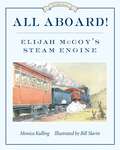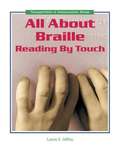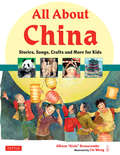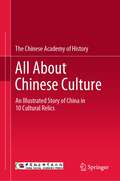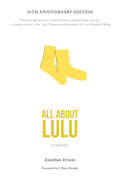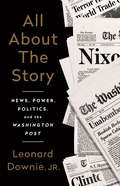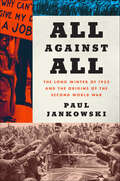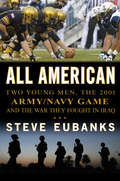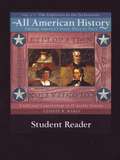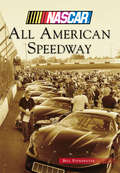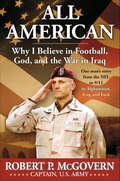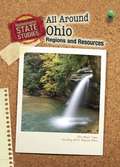- Table View
- List View
All Aboard!: Elijah McCoy's Steam Engine (Great Idea Series #2)
by Monica KullingIn the second of Tundra's Great Idea series, biographies for children who are just starting to read, Monica Kulling presents the life of an extraordinary man.There were few opportunities for the son of slaves, but Elijah McCoy's dreams led him to study mechanical engineering in Scotland. He learned everything there was to know about engines - how to design them and how to build them. But when he returned to the United States to look for work at the Michigan Central Railroad, the only job Elijah could get was shoveling coal into a train's firebox.Undaunted, he went on to invent a means of oiling the engine while the train was running, changing the face of travel around the world.With playful text and lively illustrations, All Aboard! Elijah McCoy's Steam Engine may be the first biography a child discovers, and it will whet the appetite for many more.
All About Braille: Reading By Touch (Transportation and Communication Series)
by Laura S. JeffreyFor younger children. From the Book jacket: All About Braille: Reading By Touch will tell you about Braille and finger reading. For those who cannot see or are losing their sight, Braille lets them read and communicate with others. Using special tools such as Braille writers that work like typewriters and Braille displays that hook up to computers, people can write letters and send e-mail. Learn more about the history of Braille and how it has opened the doors of communication.
All About China
by Allison BranscombeTake the whole family on a whirlwind tour of Chinese history and culture with this delightfully illustrated book that is packed with stories, activities and games. Travel from the stone age through the dynasties to the present day with songs and crafts for kids that will teach them about Chinese language and the Chinese way of life. All About China is the next best thing to being there! China is the world's largest and most populated country boasting thousands of years of history, tradition and culture. In All About China, you'll: Discover the fantastic Chinese tales about the creation of the earth and the origin of the Moon Goddess Delve into China's multifaceted cultural heritage, visit breathtaking places and learn Chinese folk songs Take a crack at solving a tangram shape puzzle Learn about the twelve Chinese zodiac animals Try your hand at making a traditional brush painting of a panda, bamboo and other subjects All About China is an exciting and captivating introduction to the country, featuring page after page of colorful illustrations, interesting stories, amazing facts, cultural insights, engaging activities and much more. Young readers will embark on a fascinating journey through the many faces of this country, meeting its people and examining its landscape, culture and historical tapestry.
All About China
by Lin Wang Allison BranscombeTake the whole family on a whirlwind tour of Chinese history and culture with this delightfully illustrated book that is packed with stories, activities and games. Travel from the stone age through the dynasties to the present day with songs and crafts for kids that will teach them about Chinese language and the Chinese way of life.All About China is the next best thing to being there!China is the world's largest and most populated country boasting thousands of years of history, tradition and culture. In All About China, you'll:Discover the fantastic Chinese tales about the creation of the earth and the origin of the Moon GoddessDelve into China's multifaceted cultural heritage, visit breathtaking places and learn Chinese folk songsTake a crack at solving a tangram shape puzzleLearn about the twelve Chinese zodiac animalsTry your hand at making a traditional brush painting of a panda, bamboo and other subjectsAll About China is an exciting and captivating introduction to the country, featuring page after page of colorful illustrations, interesting stories, amazing facts, cultural insights, engaging activities and much more. Young readers will embark on a fascinating journey through the many faces of this country, meeting its people and examining its landscape, culture and historical tapestry.
All About Chinese Culture: An Illustrated Story of China in 10 Cultural Relics
by The Chinese Academy of HistoryThis book invites senior experts and scholars from the fields of Chinese archaeology and history to describe ten influential “national treasure-level” cultural antiquities. Spanning from the Neolithic Age to modernity and with content ranging from the origin of civilizations to the red cultural relics, the book covers cultural antiquities, including: the Clay Figurine, the Painted Pottery Plate with Coiling Long Pattern (from the Neolithic Period), the Turquoise-inlaid and Long-shaped Bronze Object (of the Xia Dynasty), the Ivory Goblet Inlaid with Turquoise (of the Shang Dynasty), the He Zun (Ritual Wine Vessel), the Ox-shaped Zun (Wine Vessel), the Arm Protector with Animal and Clouds (and embroidered with the Chinese characters meaning “five stars appear in the East, which is a sign of Chinese victory over the Qiang”), the Beast-head-shaped Agate Cup (of the Tang Dynasty), the Imperial Gilt Gold Mesh Crown with Two Upright Wings (of the Ming Dynasty), etc. The text features not only scientific rigor but is also enjoyable to read and thought-provoking.
All About Darts: The ultimate guide to the world's greatest sport
by Russ BrayStand up if you love the darts!The one and only legend that is Russ 'The Voice' Bray has been the man beside the oche calling major darts tournaments since 1996. He has now hung up his mic, but stand up and rejoice as he'll be making himself heard once again in this essential, all-seeing companion to your favourite sport!Every throw counts, and Russ calls the best matches he's ever reffed, the greatest comebacks and the wildest epics. And it's access all areas as he takes us into the practice rooms to watch the mind games unfold.Russ also has a ton of stories to tell you about all the greats. Read on and cheer for the old-school superstars like Eric Bristow and Phil Taylor, and get chanting for the current contenders from Mighty Mike to Luke the Nuke.From the pubs to Ally Pally - it's GAME ON!
All About Evie
by Matson TaylorEVIE EPWORTH IS TEN YEARS OLDER. BUT IS SHE ANY WISER?! 'An absolute ray of sunshine of a book' Libby Page, author of The LidoPraise for The Miseducation of Evie Epworth &‘Tight, clever and riddled with wit. Like discovering Adrian Mole or Bridget Jones for the first time.&’ Joanna Nadin, author of The Queen of Bloody Everything &‘A sweet, fizzy sherbet dib-dab of a book - deliciously nostalgic, hugely funny and ultimately heartwarming. The perfect book for our times.&’ Veronica Henry &‘Such a joyful and uplifting read. Just the sort of thing that people will want to be reading right now.&’ Anita Rani, Radio 2 Book Club 'Full of fabulous characters, sprinkled with joy and drenched in wit.' Milly Johnson 1972. Ten years on from the events of The Miseducation of Evie Epworth and Evie is settled in London working for the BBC. She has everything she's ever dreamed of (a career, a leatherette briefcase, an Ossie Clark poncho) but, following an unfortunate incident involving Princess Anne and a Hornsea Pottery mug, she finds herself having to rethink her life and piece together work, love, grief and multiple pairs of cork-soled platform sandals. Ghosts from the past and the spirit of the future collide in a joyous adventure that sees Evie navigate the choppy waters of her messy twenties. Can a 1960s miseducation prepare her for the growing pains of the 1970s? Big-hearted, uplifting, bittersweet and tender, All About Evie is a novel fizzing with wit and alive to the power of friendship in all its forms.
All About Indonesia
by Linda HibbsAll About Indonesia is a book for children that takes them on an adventure through one of the world's largest and most culturally diverse countries. Along the way, kids are introduced to Indonesian customs, the food, the language, and the natural beauty of this fascinating country! From popular sports to traditional dances, and from everyday dress to foods and school activities, this multicultural children's book provides glimpses of the everyday life and culture of this exotic, faraway land. Kids will learn about Indonesia through stories, songs, crafts, activities and recipes:Learn basic vocabulary from the national language, Bahasa IndonesiaMake a traditional mask that is worn during special ceremonial dancesCreate beautiful batik cloths and other crafts for kidsExperience the difference between big city life in Jakarta versus village livingExplore the beaches and volcanoes in places such as Bali and SumatraEnjoy sweet cake made with coconut, and more!
All About Indonesia
by Linda HibbsAll About Indonesia is a book for children that takes them on an adventure through one of the world's largest and most culturally diverse countries.Along the way, kids are introduced to Indonesian culture and history, the food, the language, and the natural beauty of this fascinating country! From popular sports to traditional dances, and from everyday dress to foods and school activities, this multicultural children's book provides glimpses of the everyday life and culture of this exotic, faraway land.Kids will learn about Indonesia through stories, songs, crafts, activities and recipes:Learn basic vocabulary from the national language, Bahasa IndonesiaMake a traditional mask that is worn during special ceremonial dancesCreate beautiful batik cloths and other crafts for kidsExperience the difference between big city life in Jakarta versus village livingExplore the beaches and volcanoes in places such as Bali and SumatraEnjoy sweet cake made with coconut, and more!
All About Japan
by Willamarie Moore Kazumi Wilds2012 Creative Child Magazine Preferred Choice Award Winner!A cultural adventure for kids, All About Japan offers a journey to a new place--and ways to bring it to life! Two friends, a boy from the country and a girl from the city, take us on a tour of their beloved land through their eyes. They introduce us to their homes, families, favorite places, school life, holidays and more!Celebrate the cherry blossom festivalLearn traditional Japanese songs and poemsMake easy recipes like mochi (New Year's sweet rice cakes) and okonomiyaki (Japanese pizza or pancakes)Create origami frogs, samurai helmets and more!
All About Japan
by Willamarie Moore Kazumi Wilds**2012 Creative Child Magazine Preferred Choice Award Winner!**A cultural adventure for kids, All About Japan offers a journey to a new place--and ways to bring it to life! Dive into stories, play some games from Japan, learn some Japanese songs.Two friends, a boy from the country and a girl from the city, take us on a tour of their beloved land through their eyes. They introduce us to their homes, families, favorite places, school life, holidays and more! Celebrate the cherry blossom festival Learn traditional Japanese songs and poems Make easy recipes like mochi (New Year's sweet rice cakes) and okonomiyaki (Japanese pizza or pancakes) Create origami frogs, samurai helmets and more! Beyond the fun and fascinating facts, you'll also learn about the spirit that makes Japan one-of-a-kind. This is a book for families to treasure together.
All About Love (Cynster Series #6)
by Stephanie LaurensSix notorious cousins, known to the town as the Bar Cynster, have cut a swath through the ballrooms of London. Yet one by one, each has fallen in love and married the woman of his heart, until only one of them is left unclaimed...the most rakish of Stephanie Laurens' captivating clan...and he's not about to go easily. Alasdair Cynster -- known to his intimates as Lucifer -- decides to rusticate in the country before the matchmaking skills of London's mamas become firmly focused on him, the last unwed Cynster. But an escape to Devon leads him straight to his destiny in the irresistible form of Phyllida Tallent, a willful, independent beauty of means who brings all his masterful Cynster instincts rioting to the fore. Lucifer tries to deny the desire Phyllida evokes -- acting on it will land him in a parson's mousetrap, one place he's sworn never to go. But destiny intervenes, leaving him to face the greatest Cynster challenge -- wooing a reluctant bride. Phyllida has had a bevy of suitors -- her charm and wit are well known throughout the countryside -- but none of them has tempted her the way Lucifer does. His offer to teach her all about the ways of love is almost too tantalizing to resist. And though she's not yet completely surrendered, she knows only a fool stands against a Cynster...and Phyllida is no one's fool.
All About Lulu
by Jonathan EvisonThe tenth anniversary edition of a book that is "still as audaciously brilliant as it was on first read, plumbing the depths of the cruel rhapsody of obsessive love, the pain of feeling different, and the deep pleasure of finally figuring out who you really are, and who you want to be (Caroline Leavitt, New York Times bestselling author of Cruel Beautiful World)Weakness has always been a concern for William Miller: growing up vegetarian in a family of bodybuilders will do that to a person. But William is further weakened by the death of his mother, the arrival of a new step-mother, and his irrepressible crush on his new step-sister, Lulu. As Lulu faces down her own challenges, William watches his life shift into tumult and despair. Once Lulu departs for college, Will goes into the world to find himself--discovering Western philosophy, a cruel dating world, enduring friendship, and, ultimately, his true calling. Emboldened by his turn as a late-night radio personality, Will rescues himself from the self-image of weakness he’d long wished to escape. This debut novel explores the fundamental difference between where we come from--and the endless possibilities of where we may go.Now with an author's introduction and a foreword by J. Ryan Stadal.
All About Passion (Cynster Series #7)
by Stephanie LaurensNew York Times bestselling Australian author Stephanie Laurens delivers the latest tale in the immensely popular Cynster series. When Chillington is elected an 'honorary Cynster' at the end of All About Love, he knows he needs a wife , and an heir. His goal; a simple marriage without romance. He agrees to marry a woman he believes to be pliant and quiet. Unfortunately for him, the woman he thinks is Francesca Rawling is really her cousin, Franni.Francesca herself is proud, passionate and opinionated in short, the perfect bride for a Cynster...
All About Process: The Theory and Discourse of Modern Artistic Labor
by Kim GrantIn recent years, many prominent and successful artists have claimed that their primary concern is not the artwork they produce but the artistic process itself. In this volume, Kim Grant analyzes this idea and traces its historical roots, showing how changing concepts of artistic process have played a dominant role in the development of modern and contemporary art. This astute account of the ways in which process has been understood and addressed examines canonical artists such as Monet, Cézanne, Matisse, and De Kooning, as well as philosophers and art theorists such as Henri Focillon, R. G. Collingwood, and John Dewey. Placing “process art” within a larger historical context, Grant looks at the changing relations of the artist’s labor to traditional craftsmanship and industrial production, the status of art as a commodity, the increasing importance of the body and materiality in art making, and the nature and significance of the artist’s role in modern society. In doing so, she shows how process is an intrinsic part of aesthetic theory that connects to important contemporary debates about work, craft, and labor. Comprehensive and insightful, this synthetic study of process in modern and contemporary art reveals how artists’ explicit engagement with the concept fits into a broader narrative of the significance of art in the industrial and postindustrial world.
All About Process: The Theory and Discourse of Modern Artistic Labor
by Kim GrantIn recent years, many prominent and successful artists have claimed that their primary concern is not the artwork they produce but the artistic process itself. In this volume, Kim Grant analyzes this idea and traces its historical roots, showing how changing concepts of artistic process have played a dominant role in the development of modern and contemporary art.This astute account of the ways in which process has been understood and addressed examines canonical artists such as Monet, Cézanne, Matisse, and De Kooning, as well as philosophers and art theorists such as Henri Focillon, R. G. Collingwood, and John Dewey. Placing “process art” within a larger historical context, Grant looks at the changing relations of the artist’s labor to traditional craftsmanship and industrial production, the status of art as a commodity, the increasing importance of the body and materiality in art making, and the nature and significance of the artist’s role in modern society. In doing so, she shows how process is an intrinsic part of aesthetic theory that connects to important contemporary debates about work, craft, and labor.Comprehensive and insightful, this synthetic study of process in modern and contemporary art reveals how artists’ explicit engagement with the concept fits into a broader narrative of the significance of art in the industrial and postindustrial world.
All About the Story: News, Power, Politics, and the Washington Post
by Leonard Downie JrAt a time when the role of journalism is especially critical, the former executive editor of the Washington Post writes about his nearly fifty years at the newspaper and the importance of getting at the truth.In 1964, as a twenty-two-year-old Ohio State graduate with working-class Cleveland roots and a family to support, Len Downie landed an internship with the Washington Post. He would become a pioneering investigative reporter, news editor, foreign correspondent, and managing editor, before succeeding the legendary Ben Bradlee as executive editor.Downie's leadership style differed from Bradlee's, but he played an equally important role over more than four decades in making the Post one of the world's leading news organizations. He was one of the editors on the historic Watergate story and drove coverage of the impeachment of President Bill Clinton. He wrestled with the Unabomber's threat to kill more people unless the Post published a rambling 30,000-word manifesto and he published important national security stories in defiance of presidents and top officials. He managed the Post's ascendency to the pinnacle of influence, circulation, and profitability, producing prizewinning investigative reporting with deep impact on American life, before the digital transformation of news media threatened the Post's future.At a dangerous time, when health and economic crises and partisanship are challenging the news media, Downie's judgment, fairness, and commitment to truth will inspire anyone who wants to know how journalism, at its best, works.
All Against All: The Long Winter of 1933 and the Origins of the Second World War
by Paul Jankowski“This crisply written, well-documented account . . . examines diplomatic, military, political and economic developments in a crucial period leading up to WWII” (Publishers Weekly)All Against All is the story of how a single winter, between November 1932 and April 1933, put the postwar world back on the path to global conflict. Historian Paul Jankowski reveals how domestic passions within various nations colluded to drive their governments towards a war few of them wanted and none of them could control.Over these six months, collective delusions took hold in both liberal and authoritarian regimes. Hitler came to power; Japan invaded Jehol and left the League of Nations; Mussolini looked towards Africa; Roosevelt was elected; France changed governments three times; and the victors of the Great War fell out acrimoniously over war debts, arms, currency, tariffs, and Germany. A world economic conference offered hope, only to collapse when the US went its own way.All Against All reconstructs a series of seemingly disparate happenings whose connections can only be appraised in retrospect. As he weaves these stories together, Jankowski offers a cautionary tale for our times. While we do not know for certain where today’s crises will take us, we do know that those of the 1930s culminated in the Second World War.
All Along Bob Dylan: America and the World (Routledge Studies in Contemporary Literature)
by J. Roger KurtzAll Along Bob Dylan: America and the World offers an important contribution to thinking about the artist and his work. Adding European and non-English speaking contexts to the vibrant field of Dylan studies, the volume covers a wide range of topics and methodologies while dealing with the inherently complex and varied material produced or associated with the iconic artist. The chapters, organized around three broad thematic sections (Geographies, Receptions and Perspectives), address the notions of audience, performance and identity, allowing to map out the structure of feeling and authenticity, both, in the case of the artist and his audience. Taking its cue from the collapse of the so-called high-/ low culture split following from the Nobel Prize, the book explores the argument that Dylan (and all popular music) can be interpreted as literature and offers discussions in the context of literary traditions, or visual culture and music. This contributes to a nuanced and complex portrayal of the seminal cultural phenomenon called Bob Dylan.
All American
by Steve EubanksIn December 2001, as fires still burned beneath the ruins of the World Trade Center, West Point cadet Chad Jenkins and Naval Academy midshipman Brian Stann faced off at Veterans Stadium in Philadel-phia in what would become the most-watched college football game of the decade: the matchup between the Army Black Knights and the Navy Midshipmen. At opposing stadiums throughout the season, the Army and Navy teams, used to jeers from their oppo-nents' fans, had instead been greeted with standing ovations from respectful crowds who knew that these young players, military officers in training, were soon going to fight a war in the Middle East. On this day, before this momentous game, President George W. Bush--along with others such as General Norman Schwarzkopf and Senator John McCain--visited both locker rooms before watching the game from the sidelines. When Stann, a Navy linebacker, first came into contact with Jenkins, the Army quarterback, his team was behind by thirteen points. Yet he managed to land the perfect tackle against Jenkins. Though these two players would not meet again for a decade, Stann and Jenkins shared the same path: both went to war. As first-class officers serving several tours of duty, they led soldiers and marines and participated in events they never imagined possible. A moving and fascinating dual profile of honor, duty, courage, and competition, All American is a thoughtful exploration of American character and values, embodied in the lives of two remarkable young men.
All American History Student Reader: Volume 1, The Explorers to the Jacksonians
by Celeste RakesContaining hundreds of images and dozens of maps, All-American History Volume I is a complete year's curriculum for students in grades 5 - 8 when combined with the Student Activity Book and Teacher's Guide. It is also adaptable for younger and older students. The first volume covers Exploration through 1840.
All American History, Volume II: The Civil War to the 21st Century Student Reader
by Celeste W. RakesThe book contains a full year’s curriculum in 32 weekly lessons. Each lesson contains three sections examining: the atmosphere in which the event occurred, the event itself, and the impact this event had on the future of America.
All American Speedway
by Bill PoindexterIt began as a rodeo arena with bucking broncos entertaining an annual gathering for the Placer County Fair in Roseville, California, about 10 miles east of Sacramento. The rodeo grounds eventually gave way to a different kind of horsepower in 1955, when a dirt track was built. The original Roseville Speedway later became All American Speedway. The surface was paved in 1972, and three years later, its signature race, the Rose Classic, was born. Future NASCAR drivers Ernie Irvan, Mike Skinner, and more visited the track. The Rose Classic went away in the early 1990s, but NASCAR Whelen All-American Series action lives on each year.
All American: Why I Believe in Football, God, and the War in Iraq
by Robert P McGovernCaptain Robert McGovern epitomizes all that is right and good in America. One of nine children growing up in a New Jersey family, he made local headlines as a high school football phenom before becoming a star linebacker for the Kansas City Chiefs, the Pittsburgh Steelers, and the New England Patriots. When his illustrious NFL career was over, he earned a law degree from Fordham University and went to work for the New York City district attorney's office. From that vantage point he witnessed close-up the fall of the Twin Towers on that world-altering morning in September 2001—an event that inspired him to leave public life and join the U.S. Army to better serve the country he loves.As a military prosecuting attorney, Captain McGovern has advised battlefield commanders on legal rules of engagement in Afghanistan and has prosecuted suspected terrorists in Iraq. A dedicated soldier and a man of faith who has been on the front lines of the War on Terror—both at home and in the Middle East—Captain Robert McGovern is an extraordinary American with a remarkable and important story to tell—one that every American needs to hear.
All Around Ohio: Regions and Resources (Heinemann State Studies)
by Marcia SchonbergWhat are the five regions of Ohio? How do people make their living along the Ohio River? You can find the answers to these questions in All Around Ohio: Regions and Resources. This book contains many fascinating facts and figures about the diverse regions of Ohio, as well as each of their natural and artificial resources. You will also learn how these valuable resources directly affect the state's economy.
